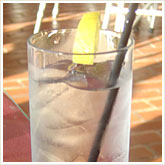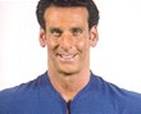You Are What You
DrinkBy Michael Sena, C.F.S.with Kirsten Straughan,
R.D., L.D., and Tom Sattler, Ed.D.
Authors of Lean Mom, Fit Family: The Six
Week Plan to a Slimmer You
and a Healthier Family
It may seem as if it will be an
uphill battle to get your family to switch from heavily advertised sodas,
energy drinks, and sugary drinks that are sold as juice to healthier beverages
such as water and milk. Believe me, though, it's a battle worth fighting.
 The high
intake of these sugar-sweetened drinks has been a driving force behind the high
incidence of obesity among our children. Did you know that one 12-ounce can of
soda has 10 teaspoons of sugar?
I'm sure that none of you would knowingly give that much sugar to your kids
with their meals or snacks. The high
intake of these sugar-sweetened drinks has been a driving force behind the high
incidence of obesity among our children. Did you know that one 12-ounce can of
soda has 10 teaspoons of sugar?
I'm sure that none of you would knowingly give that much sugar to your kids
with their meals or snacks.
Soda drinkers are also more likely
to have a lower intake of important nutrients, such as vitamin C, vitamin A,
folate, magnesium, and calcium. The decrease in calcium can result in reduced
bone mass, which can contribute to broken bones in children and can possibly
lead to osteoporosis later in life.
There are two ways to win this
battle. One is to make sure everyone understands just how dangerous sugary
drinks can be. Let your kids and spouse know that these drinks are leading
culprits in weight gain and dental problems and how the lack of dairy-based
drinks can lead to broken bones.
The other necessary tactic is to
provide healthier choices that your family will learn to love.
Good Drink Options Your Family Will Enjoy
As you are convincing your family
to decrease their sugary drink intake, you can introduce them to these better
choices.
Water. Whether it is flat or fizzy,
flavored or plain, water is a fundamental component of your family fitness plan
and is the perfect beverage for
everyone. It helps to fill you up and is important for many bodily functions.
There are many drinks masquerading as water that still have sugar or artificial
sweeteners added. Check to be sure the label lists no calories or artificial
sweeteners so you get the real deal. Show your kids that the ever-present water
bottles that lots of pro athletes, teenagers, and health-conscious young adults
carry with them are healthy and cool! Here are some ideas for making water more
appealing to your kids.
- Have plenty of flavored seltzer waters available as
an alternative to plain water.
- Use fresh lemon, lime, or other citrus fruit slices
in your water. Or try cucumber slices for a refreshing taste.
- Always keep water bottles in the car or in your kids'
backpacks to encourage water consumption.
Milk. Low-fat and
fat-free milk are healthful beverage alternatives. Next to water, low-fat or
fat-free milk and soy milk are the best beverage options for your family. Milk
contains calcium, which we often don't get enough of, as well as protein. Soy
milk is a great alternative to cow's milk, especially if you are lactose
intolerant, have problems with chronic upper respiratory infections (sinus
infections or ear infections), have asthma, or are just looking to include more
soy in your diet. Chocolate milk is okay for an occasional treat; just try to
control the amount of chocolate added to keep the sugar under control.
100 percent fruit juice. 100
percent fruit juice is just that -- it is made solely from fruit with no sugar
added. Fruit juice has the added benefit of being full of the vitamins that are
naturally found in fruit, such as vitamin C and folate. It's very important to
remember, however, that a serving is only 4 ounces. The typical juice box is 8
ounces, and many bottles can be up to 20 ounces. I would suggest limiting the
total amount of juice for the day to 4 to
8 ounces. If 8 ounces is much less
than your family is used to drinking, dilute the juice with water. Start with
25 percent water and 75 percent juice, then slowly increase the percentage of
water to 50 percent. Or try mixing juice with seltzer water for a fizzy treat.
Vegetable juice. Vegetable
juice is a great low-calorie choice that offers antioxidants, such as vitamins
A and C, and other nutrients such as lycopene, which has been linked to a
reduced risk of prostate cancer. Eight ounces of vegetable juice has 2 grams of
fiber, is very low in sugar, and has only 50 calories.
Unsweetened teas. Unsweetened
teas -- those that are already bottled -- and homemade iced or hot herbal teas
can be great calorie-free options. Black and green teas also have proven health
benefits, such as decreasing your risk of cancer and lowering cholesterol. Many
herbal teas taste sweet enough on their own, so you don't need to add any extra
sugar or honey. If they don't, try adding a small amount of 100 percent fruit
juice for a delicious blend. Teas come in many family-friendly flavors, such as
berry, orange, and cinnamon, so you have plenty of options to try. When buying
bottled teas, be sure to check the nutrition labels to make certain they have
no calories.
Sports drinks. Sports
drinks are very popular among kids, due in large part to great marketing and
advertisements. Sports drinks contain only about 50 to 80 calories per 8
ounces, making them lower in calories than juices, fruit drinks, and soda. They
don't, however, offer the nutritional benefits of 100 percent fruit juice,
vegetable juice, or milk -- so drink them only occasionally. Water is still the
best fluid choice for any activity that lasts less than 60 minutes, making it
ideal for a typical workout. Water also won't replace the calories that you're
working to burn off!
Other Drinks
Perhaps some of your favorite
drinks aren't described above -- and for good reason. Here's the skinny on some
other popular drinks that you'll want to avoid.
Diet soda. My tendency
is to recommend eating real foods and avoiding artificial sweeteners and fat
replacements, such as aspartame and Olestra. Aspartame, a common sweetener in
diet soda, has been linked to migraine headaches, among other adverse health
reactions. In addition, there is a small amount of preliminary research
indicating that your body releases insulin in response to artificial
sweeteners. The release of insulin causes your blood sugar levels to drop and
therefore makes you hungry. Trying to decrease the amount of sweeteners you
use, whether they're natural or chemical, is the best bet. However, allow
yourself to enjoy your favorite sweet occasionally, made with real sugar. If
you choose to drink diet soda or use artificial sweeteners, do so in moderation
(once or twice a week).
Coffee drinks. With the
rise of the chain coffee houses has come the popularity of creamy coffee drinks
that are chock full of sugar and calories. A 16-ounce café mocha
averages 300 to 350 calories, while a 16-ounce frozen coffee drink can have
anywhere from 300 to more than 500 calories, depending on what "extras" you
have added. Whipped cream alone can add more than 100 calories! Bakery treats
such as banana bread, muffins, and scones have, on average, between 350 and 450
calories, while a caramel sticky roll or slice of coffee cake can have upwards
of 700 calories. Yikes! You could easily get more than half of your daily
calorie allowance from your coffee break.
Fortunately, you don't have to
forgo your treat. There are many lower-calorie choices, such as a small
café latte or cappuccino made with fat-free milk (about 120
calories). You could also try a 12-ounce Chai tea with fat-free milk for about
170 calories. Choose from a selection of herbal teas or, of course, plain old
zero-calorie black java. And instead of the muffins or cake, try a crunchy
biscotti for around 120 calories.
Alcohol. Alcohol is
another underestimated calorie source. A 12-ounce beer, a 7-ounce glass of
wine, or a 2.5-ounce martini each adds around 150 empty calories. And that can
double if you're drinking a tall glass of a creamy mixer such as
piña colada. Also, alcohol tends to lower your inhibitions, so
you are more likely to take a few extra bites of dessert. In addition to
contributing to extra weight, alcohol has been shown to have differing effects
on your health. Moderate amounts of red wine (one drink a day for women and two
drinks a day for men) have been shown to lower the risk of coronary heart
disease. However, research has also shown that alcohol in higher amounts can be
a contributor to cancers of the breast, esophagus, stomach, and colon. Use
judgment and moderation when fitting alcohol into your meal plan.
Reprinted from: Lean
Mom, Fit Family: The 6-Week Plan for a Slimmer You and a Healthier
Family by Michael Sena, C.F.S. with Kirsten Straughan, R.D.,
L.D., and Tom Sattler, Ed.D. © 2005 Michael Sena. Permission granted by
Rodale, Inc., Emmaus,
PA18098
 Authors: Authors:
Michael Sena, C.F.S., is one of
America's
most respected personal trainers and fitness experts. His fitness advice has
appeared in USA Today and the
Washington Post and on CNBC and
CNN's Headline News. He was named
one of the 100 best trainers in America by
Men's Journal in 2005 and is a
founding member of Mayor Daley's Fitness Council. He lives in
Chicago.
For more information, please visit
www.michaelsena.com
Kirsten Straughan, R.D., L.D., is a
registered dietitian who has worked in a variety of settings, including
hospitals, private counseling, nutrition seminars, and fitness and nutrition
television news reports.
Tom Sattler, Ed.D., has chaired
the graduate specialization in applied exercise physiology at the
University of
Illinois in
Chicago.
Dr. Sattler has also supervised training for the NHL's Chicago Blackhawks
(1978-1982) and the Chicago Cubs (1982-1988). He is currently the director of
education and programming for the Senior FITness division of Alliance Rehab, a
Health Resources Alliance company.

Lean Mom, Fit Family: The Six Week Plan to a Slimmer You and a
Healthier Family
|